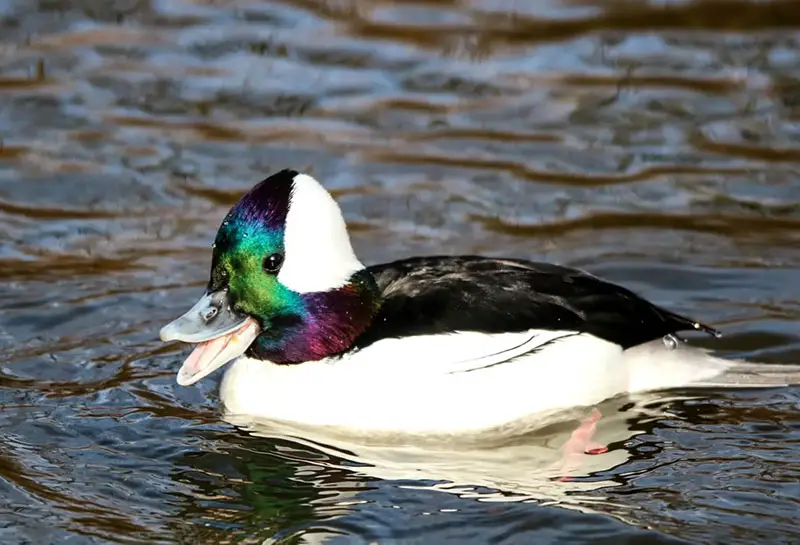Swans are big water birds that spend much of their time moving smoothly over lakes, ponds, rivers, and reservoirs. They can be found in North America, parts of South America, Europe, Australia, and Asia.
Besides their graceful movement on water, swans also have a distinctive way of flying. They stretch out their long necks and flap their big wings slowly. One type of swan, called the Mute Swan, is the biggest flying bird, weighing around 50 pounds (23 kilograms).
When swans fly together, they often arrange themselves in formations. These formations look like a V or a slanted line, which helps them save energy while flying. This way, they can fly for longer distances without needing to rest as often.
How far can swans fly?
Different types of swans travel varying distances when they migrate. Some, like the Bewick’s and Whooper swans, cover thousands of kilometers to reach their breeding areas each year. Others fly hundreds of miles every day. Certain species can fly up to about 2,000 kilometers without stopping. They migrate to find food, a better place to live or to reunite with their partner.
Among all the swan species, the Bewick’s swan migrates the farthest. They spend winters mainly in parts of the UK, covering a route of around 3,500 kilometers from Russia and the Asian tundra. They pause only briefly to eat and rest.
One Bewick’s swan was recorded flying approximately 4,000 miles (6,437 kilometers) in under ten weeks. Another swan tracked by GPS flew 831 kilometers in 36 hours during one leg of its journey, followed by an additional 1,337 kilometers in 15 hours. It averaged a speed of slightly over 55 miles per hour (89 kilometers per hour).

Image Source
How fast can swans fly?
Typically, swans fly at speeds ranging from 20 to 30 miles per hour. Some groups have been observed flying at speeds of 50 to 70 miles per hour when aided by a tailwind.
The Mute swan, with a wingspan of up to 238cm, can achieve speeds of up to 50 miles per hour (80 kilometers per hour).
How high can swans fly?
Most swans fly at altitudes of around 2,000 to 4,000 feet, depending on the species. However, during migration, some may fly at much greater heights. For instance, a group of Whooper swans was detected by radar flying over Northern Ireland at 26,500 feet (8,000 meters). Tundra swans can reach speeds of 50 to 60 mph and heights of 6,000 to 8,000 feet.
Do Swans Migrate?
Yes, swans do migrate every year. They fly from where they breed in the summer to where they spend the winter when it starts getting colder, and then they come back before spring. These migrations can be really long, and they cover thousands of miles.
When swans migrate, they can fly both during the daytime and at night. In the daytime, they fly higher up in the sky so they can follow the right path. At night, they usually fly lower, closer to the ground.
Unlike many other birds that use their natural instincts to migrate, swans learn from other swans about where to go. They remember the places where they stop during their journey and the exact path they take from where they nest in the summer to where they stay in the winter.
If something changes along their route, like if a resting place they used before is not available anymore, swans can find a new place to rest. This ability to adapt to changes in their environment helps them deal with things like climate shifts and human activities. However, scientists and people who make laws are working together to make sure swans stay protected.
Do swans fly in formation?
Swans often fly in flocks, arranged in a diagonal line or V-shaped formation during migration. One bird takes the lead and guides the flock through the air. They take turns leading; when one becomes tired, another bird steps in.
At what age can swans fly?
Young swans typically attempt their first flight around 12 weeks of age, once their flight feathers and chest muscles are strong enough. They gradually build up their strength through several trial flights.
Mute swan cygnets are unable to fly until they are between 120 to 150 days old.
How far do swans migrate?

Image Source
The distance swans migrate depends on the species. Some fly around 4,000 miles during migration, often in groups of up to 100 birds.
Whooper swans perform the longest sea-crossing migration, covering up to 870 miles (1,400 km) between the UK, Ireland, and Iceland. They can fly up to 620 miles in 12 hours at speeds of around 55 miles per hour.
During migration, Tundra swans can fly several hundred miles each day, averaging speeds of 18 to 30 miles per hour and flying at altitudes of 6,000 to 8,000 feet. Flocks have been noted flying between 50 to 60 mph with the assistance of a tailwind.
Do swans fly with their young ones?
Adult swans often fly alongside their young cygnets to join other birds in areas where they don’t breed. Tundra swan cygnets, guided by their parents, take their first long flight when they are about four months old. During this journey, they learn the migration routes and where to find food and rest.
What’s the flying range of mute swans?
The Mute swan (Cygnus Olor) is found in many parts of Europe and Asia, and it’s one of the biggest and heaviest flying birds globally. Whether or not they migrate affects how far they travel.
Some of these swans stay in their usual habitats all year, especially if there’s enough food. Others might move shorter distances to gather in winter flocks on nearby lakes and rivers.
In the UK, most resident swans stay relatively close to where they hatched, often less than 30 miles away. Only around 3% of them venture more than 60 miles from their birthplace. Migratory species in Europe might travel to North Africa, parts of India, and the Middle East for the winter.
How far can whooper swans fly?
Whooper swans are migratory and can cover significant distances. During their migration, they can fly non-stop from Scotland to Iceland, a journey of about 620 miles (1,000 kilometers).
How far can black swans fly?
Black swans (Cygnus atratus) are not known to be migrants, but they are nomadic. They often fly at night and spend the day resting in open waters while searching for suitable wetlands and abundant food sources. The exact distance they can fly varies.







One thought on “Can Swans Fly? All you Need to Know”